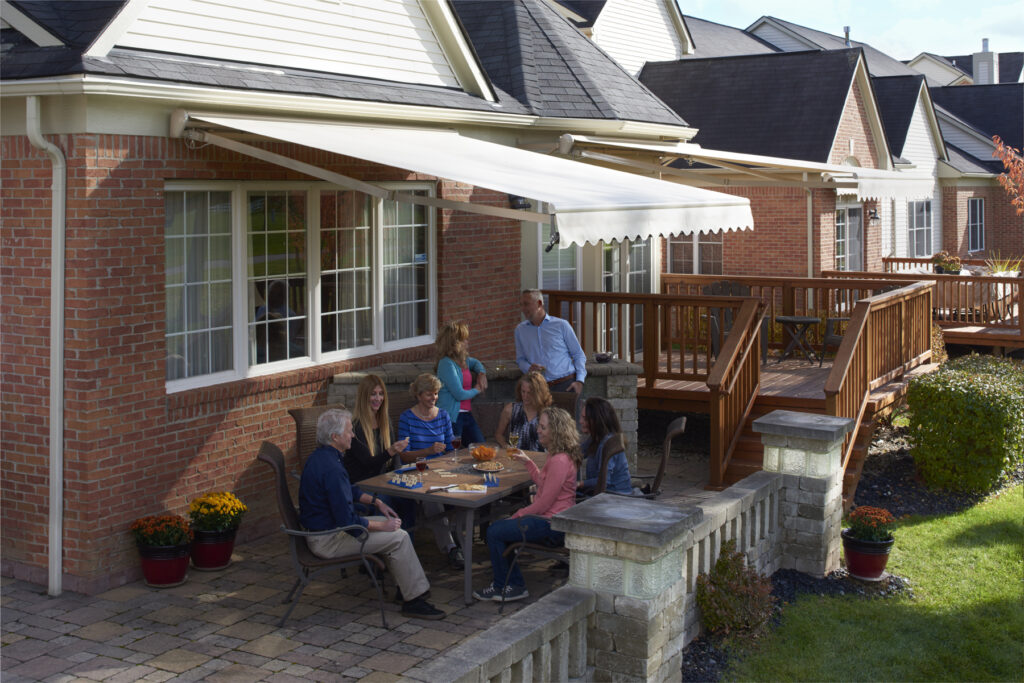An awning is a mounted exterior cover, usually fabric or metal, that provides shade, shields against rain, and extends outdoor comfort. It can be fixed or retractable, and is used over patios, doors, windows, and more.

Modern ones also come with smart features like remote control, auto-retraction in high wind, and even voice integration with Alexa, Google Assistant, or a native app.
Some models are built to respond automatically to weather changes.
When it comes to materials, here’s what you should know:
- Acrylic: Breathable and fade-resistant, ideal for consistent sun exposure and humid regions.
- Vinyl: Water-resistant and durable, suited for areas with heavy rain, though it retains more heat. Tends to be on fixed applications.
- Polyester: High-performance with vibrant color retention and mold resistance; engineered for longevity in diverse weather.
- Aluminum Frames: Lightweight, sleek, and naturally rust-resistant, great for low-maintenance durability.
- Steel Frames: Extremely sturdy; requires protective coating to avoid rust in wet environments.
- Wood Frames: Visually charming but demands frequent upkeep and is sensitive to moisture and temperature shifts.
A good awning extends your space, and your lifestyle, while saving energy and adding curb appeal.
Continue reading as we unpack everything about awnings from wind-rated designs and HOA restrictions to financing, automation, and what separates a solid awning and a shabby one!
What Is an Awning and Why It’s Become the MVP of Outdoor Living

An awning is a secondary outdoor covering, typically made from durable fabric or metal, that’s mounted to the exterior of a building.
It provides shade and protection from the elements, whether above a window, door, patio, or even freestanding over a backyard space.
But awnings today are more than functional, they’re lifestyle enablers. Once simple canvas covers, they’ve evolved into smart, retractable systems tailored for comfort and convenience.
From Shade Provider to Space Transformer
As we like to say: “It’s not just an awning. It’s a Marygrove.” And it’s true, awnings can reshape how people use their homes.
We’ve seen back decks turn into poker-night hubs and patios become quiet retreats from summer chaos.
And as outdoor living evolved, so did the role of the awning, quietly becoming the unsung hero of everyday comfort and connection.
The Modern MVP of Outdoor Living
Today’s awnings offer:
- Instant lifestyle upgrades: Your patio becomes a lounge, a dining room, or even a weekend workspace.
- Built-in tech: Smart retractables with wind sensors, remote operation, and weather-based automation.
- Emotional value: More space to host, more comfort to relax, and more memories made outdoors.
Whether it’s a poolside party or a Sunday breakfast in your backyard, the awning isn’t just above you, it becomes part of the moment.
It’s clear that awnings can change the way you live, but choosing the right one takes more than just picking a color or size.
From frame design to fabric strength, every detail affects how well it fits your space and stands up to daily use.
Beyond the Basics: Every Awning Has a Job, and a Build to Match

Choosing an awning isn’t one-size-fits-all.
The right shape, structure, and material can make the difference between daily comfort and constant hassle.
1. Start with Style: Fixed vs. Retractable
Most awnings fall into two core categories:
- Fixed Awnings are permanently extended and provide constant protection from the elements. They’re ideal for high-traffic areas or businesses that need reliable, full-time coverage.
- Retractable Awnings allow you to control your shade. These can be manually or automatically extended or retracted depending on weather or preference. They offer seasonal flexibility and tend to last longer when properly stored during harsh conditions.
But beyond how they function, awnings are also defined by where they’re used, and each space brings its own set of needs.
2. Awnings by Use Case: From Windows to Campgrounds
The functionality of an awning is also shaped by where and how it’s used:
- Window Awnings: Small and targeted, these reduce heat inside the home and protect furnishings from sun exposure.
- Door Awnings: Installed above entryways, they block rain and direct sunlight while adding architectural interest.
- Freestanding Canopies: Not attached to a structure, these are popular for gardens, poolside areas, or café patios where flexibility is needed.
2A. Close To But Not An Awning
- Vertical Drop Shades: Designed to hang vertically like a curtain, they provide sun control, wind resistance, and added privacy, especially useful on decks or balconies. Some people confuse these for awnings, but they’re just screens.
- Pergola Roofs & Louvered Systems: These upscale, fixed-frame shade structures allow homeowners to adjust the level of sunlight with rotating slats or movable panels. People normally put awnings on top or in addition to these solutions.
Some people also explore awnings for RVs and trailers, but it’s important to note that residential-grade awnings aren’t engineered for mobile mounting. It’s definitely not safe or advisable.
That said, of course, where an awning goes is only half the equation, the materials it’s made from play an equally critical role in how well it performs over time.
3. What’s It Made Of? Materials Matter

Performance, durability, and appearance all depend on the materials you choose:
Fabric Types
- Acrylic: Durable and breathable with excellent mildew resistance, ideal for sun-drenched, humid climates.
- Vinyl: Water-resistant and tough, perfect for rain-heavy areas, though it can retain more heat.
- Polyester: Engineered for resilience with strong UV protection, vibrant colors, and reliable performance across seasons.
Awning fabrics vary widely, so understanding which one you have is key to cleaning it effectively and keeping it looking its best year-round.
Frame Materials
- Aluminum: Lightweight, corrosion-resistant, and perfect for smooth retractable function.
- Steel: Exceptionally strong with high impact resistance; benefits from rust-preventive finishes.
- Wood: Naturally beautiful but demands significant upkeep and is vulnerable to the elements.
Homeowners often worry about sun-rot, fabric breakdown from UV exposure. Fixed awnings without protective housing are most at risk.
Retractable models with cassette enclosures help prevent fading by shielding fabric when not in use.
But great awning materials alone don’t guarantee performance.
To truly get your money’s worth, you also need to look at how the awning is built, how it’s protected, and how well it’s supported after installation.
What Makes a High-Quality Awning, And Why Materials Matter Most

At first glance, most awnings seem the same: a shade cover, a support frame, maybe a motorized arm.
But the real difference lies in what you don’t see, how it’s built, how it holds up, and how well it serves you long-term.
What Sets a Quality Awning Apart
When comparing options, focus on these essentials:
- Warranty: Reliable manufacturers back their work with a solid 5–10 year warranty. It’s a signal of build quality, and peace of mind for you.
- Protective Casing: Full-cassette or semi-cassette housings shield the fabric and inner mechanics from sun, moisture, and debris when retracted, dramatically extending the life of the awning.
- Wind and Weather Readiness: Wind-rated frames and automatic sensors are must-haves in areas with unpredictable weather. They help protect your investment when you’re not home.
- Service Network: Quality doesn’t end at installation. Choose a provider with accessible, responsive support in case repairs or replacements are ever needed.
How Fabric and Frame Materials Affect Longevity
Materials matter more than you think, here’s what to know:
- Acrylic: Great for sunny, humid environments. Breathable, mildew-resistant, and retains color beautifully over time.
- Vinyl: Water-resistant and sturdy, making it a smart choice for rainy climates, though it may retain warmth underneath.
- Polyester: Designed for modern performance, UV-resistant, colorfast, and built to handle both seasonal and year-round exposure.
- Aluminum Frames: Lightweight, rust-resistant, and optimal for smooth retractable function and long-term reliability.
- Steel Frames: Highly durable and impact-resistant; benefits from a protective finish to prevent corrosion.
- Wood Frames: Warm and natural in appearance, but high maintenance and less suited for extreme weather.
The best awning isn’t just the one that looks good, it’s the one built to last where you live.
But performance today isn’t just about strength, it’s also about smarts. As awnings evolve, the best ones are blending durability with automation to deliver next-level comfort and control.
The Future of Shade, Smart Features That Think for You
Modern, smart awnings are more than shade providers, they’re responsive systems designed to protect your space and adapt to your lifestyle. Here’s how smart features take them to the next level:
- Remote Control: Adjust your awning with the push of a button, no cranks, no hassle.
- Wind Sensors: Detect strong gusts and automatically retract to prevent damage.
- Smart Enabled Weather Alerts: Closes the awning during inclement weather, reducing stress on the fabric and frame.
- Voice Activation: Connect to Alexa or Google Assistant for hands-free control, open, close, or schedule your awning with a simple voice command.
- Mobile App Integration: Control your awning on the go, whether you’re inside or miles away.
- Custom Scheduling: Set your awning to extend during sunny hours and retract at dusk, even if you’re not home.
These features help answer a common worry: “What if I forget to retract it before a storm?” With smart automation, your awning responds so you don’t have to.
But high-tech isn’t helpful without durability. The best smart awnings also include:
- High Wind Ratings: Built and tested to withstand strong regional gusts.
- Cassette Housing: Encloses the fabric and arms when retracted, protecting against sun, wind, and moisture.
- Tailored Sizes: Designed to match local conditions, because weather in Arizona isn’t the same as in Michigan.
- Reinforced Arms: durable aluminum specifically designed to withstand weather and use for 20+ years.
With a smart awning, you get comfort, control, and weather-readiness, without lifting a finger.
Even with the smartest features and strongest build, there’s one more hurdle that can make or break your awning plans, your homeowners association.
The Surprise Role of Your HOA in Your Awning Decision

Before you order that perfect awning, there’s one more layer to check, your HOA. Homeowners associations often have the final say in what’s allowed on your property’s exterior, and awnings are no exception.
- Color Restrictions: Many HOAs require you to stick to a specific palette that matches the neighborhood aesthetic. Bright or bold patterns may be off-limits.
- Size and Projection Limits: You might need to adhere to maximum dimensions, especially for front-facing units or multi-story homes.
- Installation Rules: Some HOAs only allow professional installs, require concealed brackets, or limit visibility from the street.
- Approval Process: Always submit your awning specs, color swatches, product diagrams, placement details, before purchasing. Expect a 2–4 week review period.
- Hidden No-Go Zones: Some communities prohibit awnings on front-facing windows or visible patios, even if they’re retractable.
Pro tip: Get written approval before placing your order to avoid costly removal demands later. A good awning provider will even help prepare the paperwork.
Learn More About Our Condo Retractable Awnings
What Makes an Awning Worth It
From reducing energy bills to expanding your living space, a well-chosen awning delivers returns far beyond shade.
It turns unused patios into everyday escapes, transforms storefronts into customer magnets, and gives you more control over your environment, season after season.
With options that fit every climate, style, and budget, awnings are no longer a luxury, they’re a smart lifestyle investment.
Especially when backed by durable materials, automation, and installation, the payoff is comfort, value, and effortless outdoor living.

Want to make the most of your space, without the guesswork?
Marygrove offers 10-year warranties, in-house service, and smart automation features like wind sensors and voice control. Get a free in-home estimate and see how effortless comfort can be.


